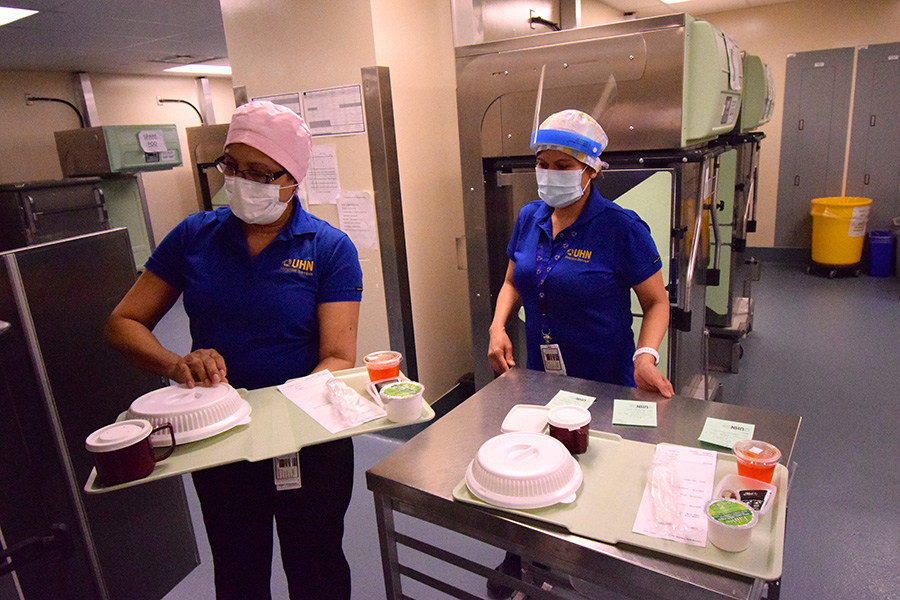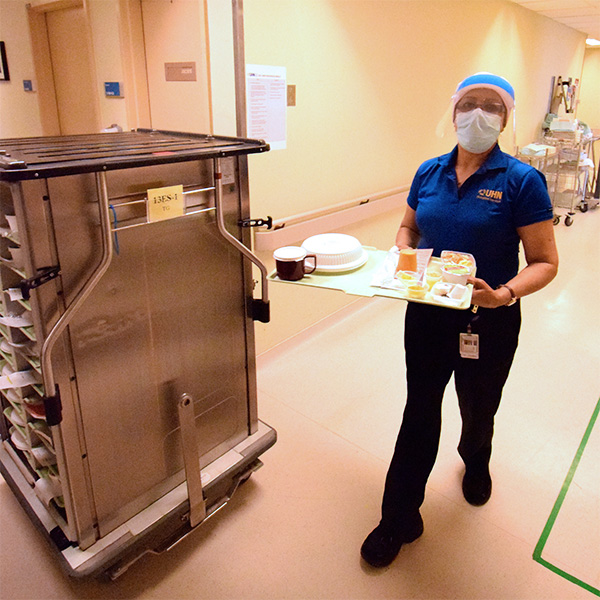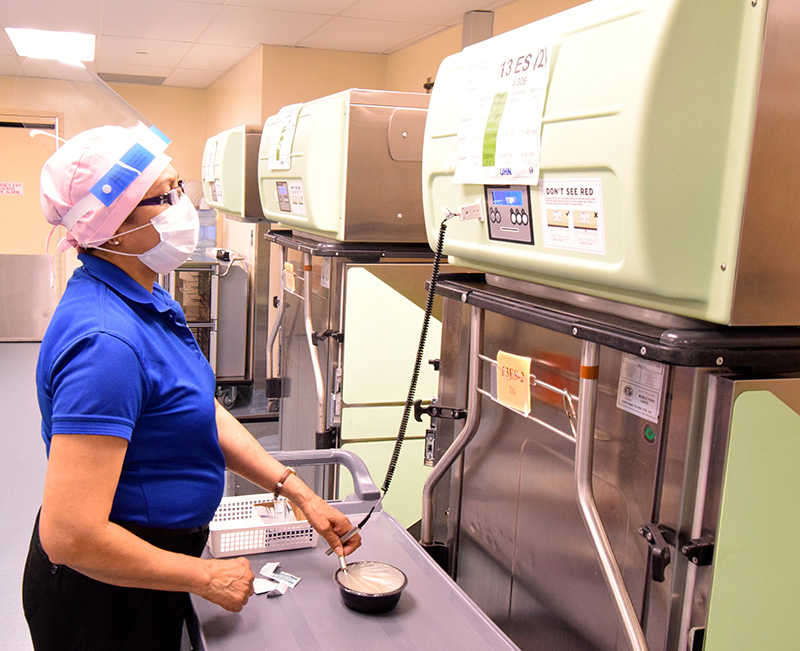Nutrition aide Mina Zierer is part of a team over 200-strong who serve up more than 20,000 meals each week across six UHN hospital sites with inpatients. (Photo: UHN)
It’s barely 6:30 a.m. and Mina Zierer is already moving quickly.
Her shift has just started in the Toronto General Hospital (TGH) Nutrition Centre on the fourth floor Eaton Wing and there’s work to be done before breakfast for inpatients begins in 45 minutes.
There’s no easing into the day.
For starters, diet clerk Marie Turnbull has a fistful of late changes Mina and fellow nutrition aide Jocelyn Quines will need to make to the meal trays in the retherm carts – called pods – ahead of delivery to floors throughout the hospital. Marie, who starts her day 30 minutes earlier, has reviewed the electronic patient record (EPR) to see if any diet changes were made overnight by ward clerks, nurses, dietitians or physicians. There’s also been phone calls to tell her about newly-admitted patients who need a meal.
While Marie double checks EPR to make sure she’s got all changes and calls the Emergency Department (ED) to determine how many breakfasts will be needed there, Mina and Jocelyn set about switching items and meals among nearly 40 retherm carts spread over two large rooms. One patient has a new test scheduled and cannot eat breakfast, so the tray is removed and a tag inserted to explain the change. Another is now on a low-lactose diet, which requires substituting the milk, yogurt and coffee cream. Both women move with efficiency and teamwork, completing modifications in about 20 minutes.
“Your brain has to be ticking,” says Mina, who joined The Doctors Hospital in 1991 soon after emigrating from her native Trinidad, and moved to TGH in 1997 as part of the merger process creating UHN.
“We can’t just throw things on a tray. We have to make sure we get patients the right foods and pay attention to any allergies they may have. We definitely play our part in caring for patients.”
Across UHN, more than 200 Nutrition Services employees, part of the Facilities Management-Planning Redevelopment & Operations (FM-PRO) Department, are involved in getting meals to patients. The process includes receiving and storing food deliveries, preparing sandwiches, salads and snacks, assembling meals on beltlines at TGH and Toronto Rehab-University Centre, heating meals and adjusting trays in the retherm areas, which are known as nutrition centres, delivery of meals to patients, and clean-up, including washing and sanitization of trays and dishware.
Together, the team serves up more than 20,000 each week at all six UHN hospital sites with inpatients.
It’s fast-paced, physical work. Except for a one-hour break between breakfast and lunch service, it’s eight hours of perpetual motion for Mina, Jocelyn and the three other nutrition aides, who start at 7:30 a.m. Late menu changes. Heating meals. Delivery. Drop-off to any individuals missed. Pick-up. Docking new meal carts into the retherm areas for the next meal and delivering in-between meal snacks.
COVID-19 has added to their challenge. Face shields are required when delivering meals, something that raises their temperature when pushing wheeled retherm carts that weigh up to 450 pounds when full.
“At first it was hard but now we’re used to it,” Jocelyn says of the plastic shield that can feel suffocating. Today, like many others during 15 years at UHN, she’ll walk about 15,000 steps, according to her watch.
There’s also the fear of becoming infected with the virus, or passing it on to family or friends.
“You just know you can never let your guard down,” says Mina, who’s had one dose of vaccine and two COVID-19 tests after outbreaks on units where she delivered meals. “One little slip up is all it takes.”
With the changes for breakfast complete, the retherm carts begin coming to life, heating the hot cereal and tea or coffee on one side of the pod while the other side remains refrigerated for the milk, butter, juice and fruit. Start times are staggered so meals will still be hot when received by patients.
Mina then packs bagged breakfasts for 10 patients in the ED. Each contains cold cereal, one per cent milk, orange juice, bread, jam, butter and fruit. They get delivered to the ED for nurses to distribute.
By 7:15 a.m., the first two retherm carts have finished heating. Mina inserts a probe thermometer into the oatmeal on a tray in the middle of each cart to ensure it has reached the appropriate temperature before wheeling the carts to the service elevator for the ride up to the Internal Medicine Inpatient Unit on the 13th floor.

Mina parks the first cart into a designated spot off to the far side of the Nursing Station, out of the way of nurses and other staff busily completing morning routines. She grabs the second and pushes off down the hall, pausing at each room to make sure the patient name on the door matches the one on the tray.
“Good morning, your breakfast is here,” Mina says brightly as she enters the room with a tray, completing another safety check as she confirms the patient’s medical record number and hospital arm band name are the same as on the tray. It’s a brief interaction but she makes sure a connection is made.
“It’s important to greet the patients,” Mina says. “You can’t just put the meal down in front of them.”
As she moves down the hall with the cart, many of the staff greet Mina by name. At one door, an isolation sign bars her entry, so she hands off the tray to a nurse, warning her to grab the cool side. Inside another room, she chats for a few moments with a patient sitting up on the edge of his bed.
“He wanted salt,” Mina explains later. “We both know he can’t have it, but you still listen.”
Meals from both carts delivered – “Everybody got a tray, so we won’t have to come back,” she says – Mina goes to the “soiled utility” room to gather dirty trays from last night, loading them into the cart.
Service to her first floor done, Mina is quickly on the elevator to go down and grab the next set of meals, these ones destined for a COVID unit. She won’t take these trays into each room, instead leaving the cart in the corner for the nursing staff on the floor to get the meals for the patients.
“You see people hooked up on machines and you know some are fighting for their lives,” Mina says. “It makes you very thankful to be healthy and hopefully able to do your part to help them through it.”

With one of the units where she normally delivers meals closed for cleaning and possible conversion into a COVID unit, Mina has time to help Jocelyn complete her breakfast rounds. Once all five nutrition aides have helped each other serve meals to inpatients throughout TGH, it’s time for 8:45 a.m. huddle.
Supervisor Melina Ramiro tells the group a COVID-19 outbreak is likely to be declared on an inpatient unit on the seventh floor. She reminds everyone the importance of protecting themselves at all times.
“Our role is huge,” Melina says when asked what she wants people to know about their work.
“Patients don’t look forward to the phlebotomists coming to draw their blood, but they do look forward to us coming with their meal,” she adds with a laugh.
Nutrition aide Marc Bourque, who has been at UHN for about eight years, says he finds it inspiring.
“I love having contact with the patients,” Marc says. “You meet people when they’re at their worst, and their grace just amazes me.
“And, the nurses I work with are incredible. They walk the talk.”
The huddle complete, the team fans out to the floors to pick up the breakfast trays. Moving room-to-room, Mina politely asks patients if they’re finished the meal before removing their tray. Some nurses hand her the used tray, others have stacked them in the “soiled utility” room for collection.

The pods now loaded with the used trays, Mina heads to the basement to drop them off. From here, they will be cleaned, sanitized and put back into circulation for the next meal.
Headed back to the fourth floor to start the late-change routine for the lunch trays, the service elevator door opens. It grows silent as a body on a bed and under a sheet is wheeled out on the way to the morgue.
“You never get used to that, even though we know it happens in the environment we’re in,” Mina says.
Back on the fourth floor, the motion never stops. While some members of the team deliver carts of snacks to the units, others make late changes to the lunch trays, now docked into the retherm base stations. One patient needs a “dental soft” diet, so butter chicken and vegetable soup is swapped out for white fish and broth. Other substitutions are made for a low-sodium diet, another for clear fluids.
Throughout the routine of getting each meal organized, heated and delivered, teamwork is on display. If one person finishes their task, they lend a hand to another, pulling pods to the elevator for each other, completing meal substitutions, accompanying a colleague to a unit to complete the tray clean-up.
“We all know that the little things can help a lot,” Mina says. “We work well together.”
